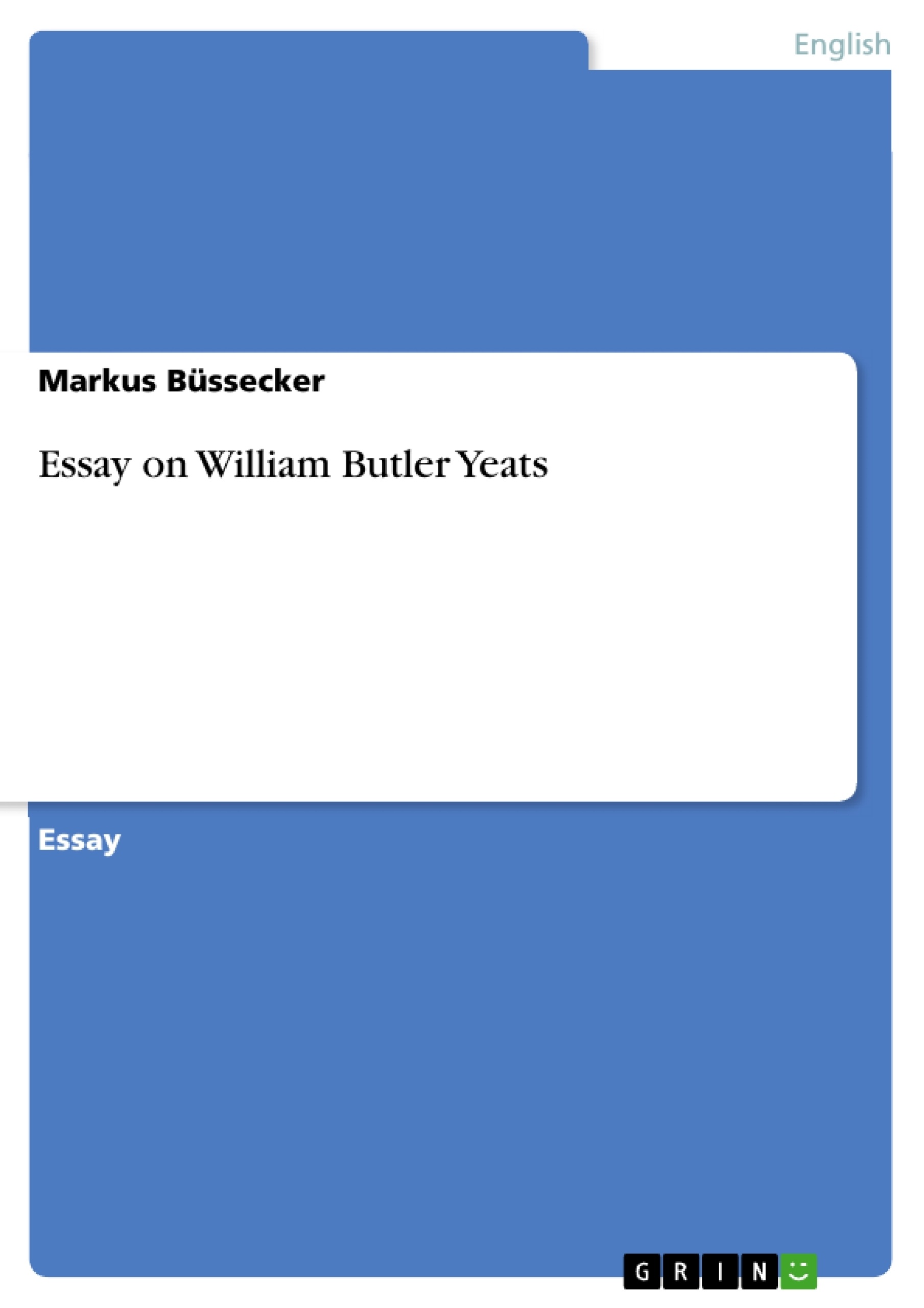Der Essay behandelt die schwierige Situation des jungen Yeats zwischen Literatur und Politik der 1890er Jahre in Irland.
Essay Question 2: ‘Yeats’s early work dances an elaborate gavotte between patriotism and Aestheticism.’ Discuss.
In order to approach the given discussion topic it is necessary to define approximately the period in which Yeats’s early work can be found. It is widely accepted amongst his biographers that Yeats’s literary career began in March 1885 when he published the two poems Song of the Faeries and Voices in an issue of the Dublin University Review. Much more difficulties occur when one wants draw a line to the end of this early period. Various attempts, each of them coherent in its approach, have recently been made. For this essay, it seems appropriate to follow critics like Alasdair Macrae[1], who point out a major shift in Yeats’s style at some stage from 1900 to 1910. In regard of this line of criticism the final year of the artist’s early oeuvre is identified with 1902 when Cathleen ni Houlihan premiered at the new-found Abbey Theatre. This event marks the completion of Yeats’s apprenticeship as an artist in all three major literary genres. It was followed by a transitional stage which included the decisive meeting of the American Modernist poet Ezra Pound and the tragic death of his close friend John Millington Synge in 1909.
Only a few artists left such an extended corpus of autobiographic writing through which their work can be attained. Therefore, the works Autobiographies (1914) and Essays & Introductions (1938) supply this essay with the needed theoretical background to trace Yeats’s patriotism as well as aestheticism in the time from 1885-1902. Every literary genre is represented with a specific sample to show the application of the developed theories. In some cases contemporary critics are used as references to underline statements. Yeats was a Man of the Mask, but he was also a Man of Unity. George Bornstein points out this consistent duplicity:
A lifelong if sometimes ambivalent Romantic, Yeats saw literature and politics as intertwined, even when he opposed the reduction of literature to mere opinion. For him “Romantic Ireland” meant the that large-minded attitude beyond the mere calculation of economic or political advantage that he saw in the present, an attitude for him incarnated in his sometime Fenian mentor John O’Leary.[2]
The following essay is dedicated to the explorations of the synthesis of patriotism and aestheticism in Yeats’s early work.
Until the mid 1880s Yeats was entirely occupied to develop a first profile as a poet for himself. He relied heavily on his reading of classic British Romanticists like Percy Bysshe Shelley or Edward Blake. There can also be stated a certain affinity to Shakespeare and the ancient Greek epics composed by Homer. W. B. Yeats struggled with his own aesthetic conception. A first result of his constant occupation was the already mentioned publication of his poems that were immediately succeeded by his first play The Island of Statues (1885). A short time after, he met John O’Leary, the old leader of the Fenian Movement. In O’Leary the young Yeats found a father figure, but even more importantly he found his mentor. He joined the Young Ireland Society and became a constant member of the discussion forum provided by O’Leary. Even in the retrospective of the Autobiographies O’Leary looms large. Yeats remarks:
From these debates, from O’Leary’s conversation, and from the Irish books he lent or gave me has come all I have set my hand to since. I had begun to know a great deal about the Irish poets who had written in English. I read with excitement books I should find unreadable to-day, and found romance in lives that had neither wit nor adventure.[3]
As a sudden, Yeats found the subject-matter for his work. In the aftermath of these encounters Yeats focused more and more on the shaping of a national literature, which would function as a unifying entity in the political struggle of Ireland for freedom. Once Yeats had a certain ideal in mind he made intensive use of recent publications in Irish history like Standish O’Grady’s History of Ireland (1878) and his later personal relationships with foremost representatives of the Irish Literary Revival like Thomas William Haze Rolleston and Lady Augusta Gregory. “Irishness” became a new key-term in Yeats’s vocabulary:
[…] and might we not make those stories current among the educated classes, rediscovering for the work’s sake what I have called “the applied arts of literature”, the association of literature, that is, with music dance; and at last, it might be, so deepen the political passion of the nation that all, artist and poet, craftsman and day-labourer would accept a common design?[4]
[...]
[1] (see Macrae, Alasdair D.F. W. B. Yeats: A Literary Life. Dublin: Gill&Macmillan Ltd, 1995.
[2] (Bornstein In: Howes 19).
[3] (Autobiographies (AB) 101).
[4] (AB 194).
- Citation du texte
- Markus Büssecker (Auteur), 2007, Essay on William Butler Yeats, Munich, GRIN Verlag, https://www.grin.com/document/88578
-

-

-

-
Téléchargez vos propres textes! Gagnez de l'argent et un iPhone X. -

-
Téléchargez vos propres textes! Gagnez de l'argent et un iPhone X. -

-
Téléchargez vos propres textes! Gagnez de l'argent et un iPhone X. -

-
Téléchargez vos propres textes! Gagnez de l'argent et un iPhone X. -

-
Téléchargez vos propres textes! Gagnez de l'argent et un iPhone X.

